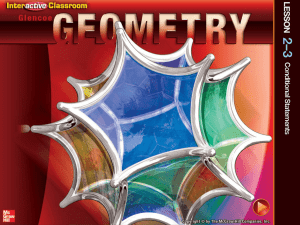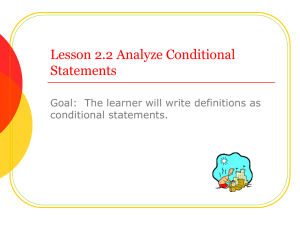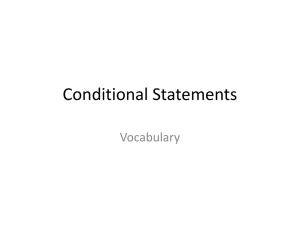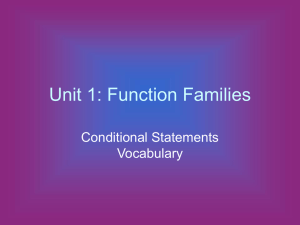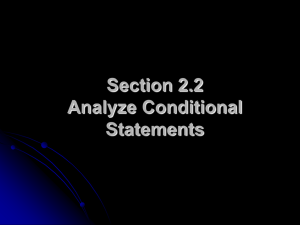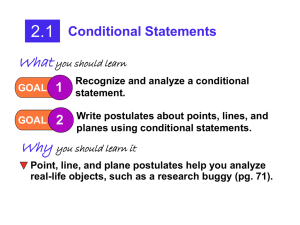A. True
advertisement
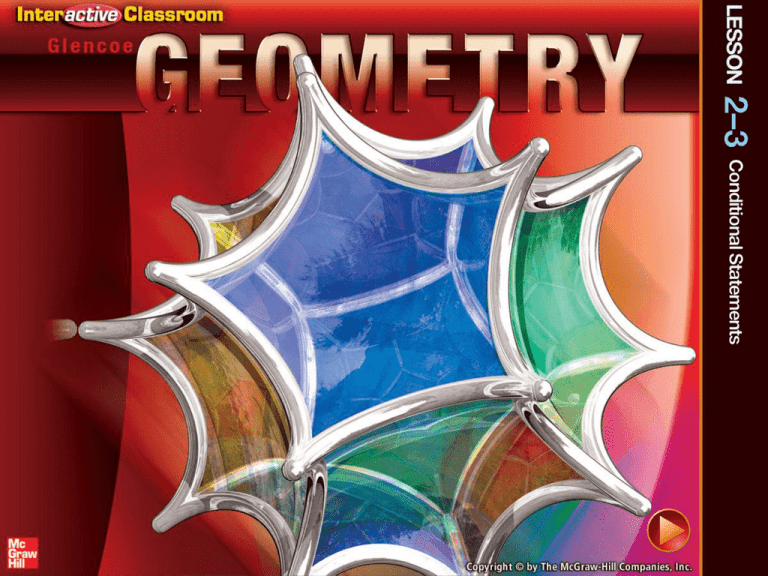
Five-Minute Check (over Lesson 2–2) Then/Now New Vocabulary Key Concept: Conditional Statement Example 1: Identify the Hypothesis and Conclusion Example 2: Write a Conditional in If-Then Form Example 3: Truth Values of Conditionals Key Concept: Related Conditionals Key Concept: Logically Equivalent Statements Example 4: Related Conditionals Over Lesson 2–2 Use the following statements to find the truth value of p and r. Write the compound statement. p: 12 + (–4) = 8 q: A right angle measures 90 degrees. r: A triangle has four sides. A. True; 12 + (–4) = 8, and a triangle has four sides. B. True; 12 + (–4) 8, and a triangle has four sides. C. False; 12 + (–4) = 8, and a triangle has four sides. D. False; 12 + (–4) 8, and a triangle has four sides. Over Lesson 2–2 Use the following statements to find the truth value of q or r. Write the compound statement. p: 12 + (–4) = 8 q: A right angle measures 90 degrees. r: A triangle has four sides. A. True; a right angle measures 90 degrees, or a triangle has four sides. B. True; a right angle measures 90 degrees, or a triangle does not have four sides. C. False; a right angle does not measure 90 degrees, or a triangle has four sides. D. False; a right angle measures 90 degrees, or a triangle has four sides. Over Lesson 2–2 Use the following statements to find the truth value of ~p or r. Write the compound statement. p: 12 + (–4) = 8 q: A right angle measures 90 degrees. r: A triangle has four sides. A. True; 12 + (–4) = 8, or a triangle has four sides. B. True; 12 + (–4) 8, or a triangle has four sides. C. False; 12 + (–4) 8, or a triangle does not have four sides. D. False; 12 + (–4) 8, or a triangle has four sides. Over Lesson 2–2 Use the following statements to find the truth value of q and ~r. Write the compound statement. p: 12 + (–4) = 8 q: A right angle measures 90 degrees. r: A triangle has four sides. A. True; a right angle does not measure 90 degrees or a triangle has four sides. B. True; a right angle measures 90 degrees and a triangle does not have four sides. C. False; a right angle does not measure 90 degrees and a triangle does not have four sides. D. False; a right angle does not measure 90 degrees and a triangle has four sides. Over Lesson 2–2 Use the following statements to find the truth value of ~p or ~q. Write the compound statement. p: 12 + (–4) = 8 q: A right angle measures 90 degrees. r: A triangle has four sides. A. True; 12 + (–4) = 8, or a right angle measures 90 degrees. B. True; 12 + (–4) 8, or a right angle does not measure 90 degrees. C. False; 12 + (–4) = 8, or a right angle measures 90 degrees. D. False; 12 + (–4) 8, or a right angle does not measure 90 degrees. Over Lesson 2–2 Consider two statements a and b. Given that statement a is true, which of the following statements must also be true? A. a or b B. a and b C. ~a D. ~b You used logic and Venn diagrams to determine truth values of negations, conjunctions, and disjunctions. • Analyze statements in if-then form. • Write the converse, inverse, and contrapositive of if-then statements. • conditional statement • contrapositive • if-then statement • logically equivalent • hypothesis • conclusion • related conditionals • converse • inverse Identify the Hypothesis and Conclusion A. Identify the hypothesis and conclusion of the following statement. If a polygon has 6 sides, then it is a hexagon. If a polygon has 6 sides, then it is a hexagon. hypothesis conclusion Answer: Hypothesis: A polygon has 6 sides. Conclusion: It is a hexagon. Identify the Hypothesis and Conclusion B. Identify the hypothesis and conclusion of the following statement. Tamika will advance to the next level of play if she completes the maze in her computer game. Answer: Hypothesis: Tamika completes the maze in her computer game. Conclusion: She will advance to the next level of play. A. Which of the choices correctly identifies the hypothesis and conclusion of the given conditional? If you are a baby, then you will cry. A. Hypothesis: You will cry. Conclusion: You are a baby. B. Hypothesis: You are a baby. Conclusion: You will cry. C. Hypothesis: Babies cry. Conclusion: You are a baby. D. none of the above B. Which of the choices correctly identifies the hypothesis and conclusion of the given conditional? To find the distance between two points, you can use the Distance Formula. A. Hypothesis: You want to find the distance between 2 points. Conclusion: You can use the Distance Formula. B. Hypothesis: You are taking geometry. Conclusion: You learned the Distance Formula. C. Hypothesis: You used the Distance Formula. Conclusion: You found the distance between 2 points. D. none of the above Write a Conditional in If-Then Form A. Identify the hypothesis and conclusion of the following statement. Then write the statement in the if-then form. Measured distance is positive. Answer: Hypothesis: A distance is measured. Conclusion: It is positive. If a distance is measured, then it is positive. Write a Conditional in If-Then Form B. Identify the hypothesis and conclusion of the following statement. Then write the statement in the if-then form. A five-sided polygon is a pentagon. Answer: Hypothesis: A polygon has five sides. Conclusion: It is a pentagon. If a polygon has five sides, then it is a pentagon. A. Which of the following is the correct if-then form of the given statement? A polygon with 8 sides is an octagon. A. If an octagon has 8 sides, then it is a polygon. B. If a polygon has 8 sides, then it is an octagon. C. If a polygon is an octagon, then it has 8 sides. D. none of the above B. Which of the following is the correct if-then form of the given statement? An angle that measures 45° is an acute angle. A. If an angle is acute, then it measures less than 90°. B. If an angle is not obtuse, then it is acute. C. If an angle measures 45°, then it is an acute angle. D. If an angle is acute, then it measures 45°. Truth Values of Conditionals A. Determine the truth value of the conditional statement. If true, explain your reasoning. If false, give a counterexample. If you subtract a whole number from another whole number, the result is also a whole number. Counterexample: 2 – 7 = –5 2 and 7 are whole numbers, but –5 is an integer, not a whole number. The conclusion is false. Answer: Since you can find a counterexample, the conditional statement is false. Truth Values of Conditionals B. Determine the truth value of the conditional statement. If true, explain your reasoning. If false, give a counterexample. If last month was February, then this month is March. When the hypothesis is true, the conclusion is also true, since March is the month that follows February. Answer: So, the conditional statement is true. Truth Values of Conditionals C. Determine the truth value of the conditional statement. If true, explain your reasoning. If false, give a counterexample. When a rectangle has an obtuse angle, it is a parallelogram. The hypothesis is false, since a rectangle can never have an obtuse angle. A conditional with a false hypothesis is always true. Answer: So, the conditional statement is true. A. Determine the truth value of the conditional statement. If true, explain your reasoning. If false, give a counterexample. The product of whole numbers is greater than or equal to 0. A. True; when the hypothesis is true, the conclusion is also true. B. False; –3 ● 4 = –12 B. Determine the truth value of the conditional statement. If true, explain your reasoning. If false, give a counterexample. If yesterday was Tuesday, then today is Monday. A. True; when the hypothesis is true, the conclusion is false. B. False; today is Wednesday. C. Determine the truth value of the conditional statement. If true, explain your reasoning. If false, give a counterexample. If a triangle has four right angles, then it is a rectangle. A. True; the hypothesis is false, and a conditional with a false hypothesis is always true. B. False; a right triangle has one right angle. Related Conditionals NATURE Write the converse, inverse, and contrapositive of the following true statement. Determine the truth value of each statement. If a statement is false, give a counterexample. Bats are animals that can fly. Bats are not birds, they are mammals. Bats have modified hands and arms that serve as wings. They are the only mammals that can fly. Related Conditionals Conditional: First, rewrite the conditional in if-then form. If an animal is a bat, then it can fly. This statement is true. Converse: If an animal can fly, then it is a bat. Counterexample: A bird is an animal that can fly, but it is not a bat. The converse is false. Related Conditionals Inverse: If an animal is not a bat, then it cannot fly. Counterexample: A bird is not a bat, but it is an animal that can fly. The inverse is false. Contrapositive: If an animal cannot fly, then it is not a bat. The converse is true. Related Conditionals Check Check to see that logically equivalent statements have the same truth value. Both the conditional and contrapositive are true. Both the converse and inverse are false. Write the converse, inverse, and contrapositive of the statement The sum of the measures of two complementary angles is 90. Which of the following correctly describes the truth values of the four statements? A. All 4 statements are true. B. Only the conditional and contrapositive are true. C. Only the converse and inverse are true. D. All 4 statements are false.
